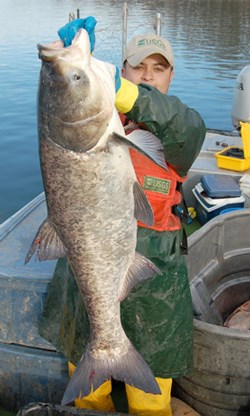
United States Geological Survey What are carp?Carp are a family of fish native to Europe and Asia. The common carp (Cyprinus carpio) has been in the US for over 100 years. The newest carp invaders, bighead carp, black carp, grass carp, and silver carp (collectively known as "invasive carp"), however, are causing their own brand of trouble in the Mississippi River and rivers and lakes within the Mississippi rivershed. These four species of fish were introduced to the U.S. in the 1970's to control algae, weed, and parasite growth in aquatic farms, weeds in canal systems, and as one form of sewage treatment. These captive fish eventually escaped into the Mississippi River basin and established breeding populations. Invasive carp are slowly making their way up the Mississippi River and its tributaries, and have been found as far north as Minnesota, including individual silver and bighead carps within the Mississippi National River and Recreation Area. There is no indication that they are spawning here, but they still represent a threat to our valued aquatic ecosystems. Why are carp a problem?Invasive carp cause serious damage to the native fish populations in the lakes and rivers that they infest because they out-compete other fish (video, 1 min) for food and space. Carp are also thought to lower water quality, which can kill off sensitive organisms like native freshwater mussels. Invasive carp have been known to dominate entire streams (video, 45 sec), effectively pushing out the native species. Silver carp are known to jump out of the water to escape threats. This behavior, by such large fish, can injure boaters, skiers, and damage boats and onboard equipment. Experts are worried that if these fish get into the Great Lakes, they may negatively affect the area's $7 billion/year fishing industry and if they spread further north in Minnesota they could threaten the resort and sport fishing industry. By out-competing native fish species for food and habitat, carp may reduce the populations of native fish that are so important to anglers. How do carp spread?Invasive carp (especially silver carp) may be capable of jumping over some barriers, including low dams. High water often creates an "open river" condition as Mississippi River dams open their gates, which may allow invasive carps to move past what is otherwise a barrier. Flooding can spread these fish as well, because flooding can connect water bodies that aren't normally connected. Invasive carp are also spread by humans. The release of live bait containing young carp has introduced these fish to other water bodies. Barge and recreational watercraft moving through Mississippi River locks may also permit invasive carp to move through as well. Releasing even a few carp into a body of water can become a huge problem. While the adult carp prefer slow moving water, they look for high, fast moving water when laying eggs (spawning). They lay hundreds of thousands of eggs at a time, which means populations grow and spread quickly. Because of this, they can quickly out-compete native species, and put ecosystems in danger. 
Photo: Ted Lawrence, Great Lakes Fishery Commission What do carp eat?The invasive carp are voracious feeders and they can become quite large. Exceptional individuals may weigh as much as 110 pounds, although most are smaller. Bighead and silver carp eat plankton, which native mussels and fish depend on. Grass carp consume plants, and can drastically change river and shoreline vegetation and spawning and cover for native fish. Black carp eat snails and mussels, including native species that are already endangered and may endanger reintroduced populations. What is being done?State and federal agencies are monitoring the Mississippi River and its tributaries for invasive carp and studying a number of ways that could prevent the further spread of these species. The Minnesota Aquatic Invasive Species Research Center (MAISRC) is a very good source of information on research and technologies pertaining to barriers and other control measures. The United States Geological Survey (USGS) ) has additional information on similar subjects. What you can do:
|
Last updated: March 6, 2023
